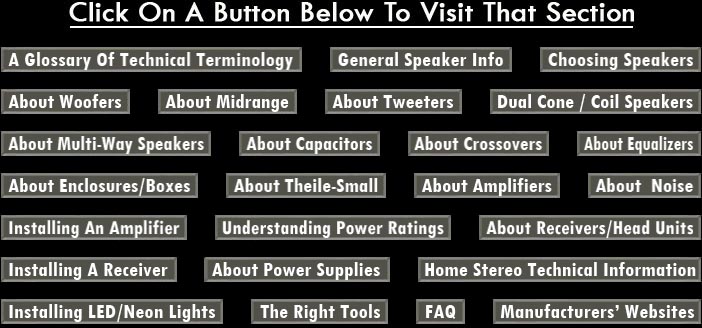


Imaging
Imaging describes the extent to which an audio system reproduces the directional cues that enable the listener to locate the instruments and vocalists as they were positioned during recording and mixing (See also Soundstage below). Good imaging creates a listening experience that seems natural and lifelike. Since directional cues in sound come mainly in the higher frequencies, the key to attaining the best possible imaging is to have equal and unobstructed path lengths between the tweeters and the listener's ears. That's one of the reasons why matched component speakers, with their versatile tweeter placement, sound as good as they do.
Impedance
The totality measured in Ohms of all electrical opposition to current flow: resistance, reactance, capacitance, as well as all mechanical factors inhibiting the completion of energy transfer in a contained system. In practical terms, this means that most Drivers are assigned a certain nominal impedance based on their DC voice coil resistance and mechanical stiffness. For car audio this is usually 4 ohms; for home stereo, 8 ohms is the standard.
Infrasonic
Waves or vibrations with frequencies below that of audible sound (20 Hz.).
Inductive Coupling
Radiated noise that is transmitted through a magnetic field to surrounding lines. This frequently occurs in long runs owire where power and signal cables are in too close proximity. This is a frequent source of noise and interference.
Inductor
A transformer, or an electrical component in which impedance increases as the frequency of the AC decreases. Also known as coils. In audio, these are used in passive crossovers. Inductors are rated in Henrys.
Input Overload Distortion
Distortion caused by too great an input signal being sent to an amplifier or preamplifier. It is not affected by volume control settings and often occurs when mics are positioned too close to the sound source. This distortion may be controllable through the use of an attenuator or pad.
Infinite Baffle
An infinite baffle speaker design is defined as an enclosure that contains a greater volume of air than the Vas requirement of the driver. An infinite baffle system can easily be applied to an automobile. This is accomplished by mounting the speakers on a board and using the trunk of the vehicle as the other walls of the enclosure. It is important that the enclosure be tightly sealed such that no air moves from the front to the back of the cone. Look for speakers where the Qts is greater than .6, and a Vas figure lower than the volume available, when selecting a woofer for an infinite baffle system.
IHF
Institute of High Fidelity - the premier institution for high fidelity whose standards have come to be universally recognized in application to the operation and design of sound re-enforcement and reproduction equipment.
Input Sensitivity
is the SPL (sound pressure level) a speaker will produce given one watt of power as measured from one meter away given a typical input frequency (usually 1kHz unless otherwise noted on the speaker). Typical sensitivities for car audio speakers are around 90dB/Wm. Some subwoofers and piezo horns claim over 100dB/Wm. However, some manufacturers do not use true 1W tests, especially on low impedance subwoofers. Rather, they use a constant voltage test which produces more impressive sensitivity ratings.
Input Voltage
The power voltage provided to an amplifier. While most cars can be expect to reliably produce 12 volts, amplifiers are sometimes measured at higher voltages; up to 15 volts. In this way, higher power can be developed, albeit at the expense of longevity. It is a practice that allows higher power figures to be claimed.
Insertion Loss
The loss of voltage (or power), as measured in dB, resulting from placing a resistor (or some other power absorbing network or component) between a voltage or power source (amp) and its load impedance (speaker.) It is the ratio of the voltage (or power) absorbed in the load without the resistor (or network) to that when the network is inserted. For example, if the voltage across a load is 2 volts without a network and 1 volt with the network, then the insertion loss is stated as 6 dB.
Interface
A device or protocol which facilitates the linking of any two devices or systems; or when used as a verb ('to interface'), the process of linking.
Intermodulation Distortion
A species of Distortion that results when one set of frequencies is superimposed on, or is modified by, another to produce a third frequency not present in the original signal. Quantifies the distortion products of nonlinearities in the unit under test that causes complex waves to produce beat frequencies, i.e., sum and difference products not harmonically related to the fundamentals.
Insulation or insulator
A non-conductive protective covering for electrically active parts and wire that prevents short circuits and other unwanted interference.
Inverse Square Law
In mathematics, the law that states that in the absence of reflective surfaces, sound pressure (or light) falls off at a rate inverse to the square of the distance from its source. In other words, every time the distance from the sound source is doubled, the sound pressure level is reduced by a factor of 4, or 12 dB.
Inverted Dust Cap (see Dust Cover/Cap)
Isobarik
Sometimes spelled Isobaric, this is an enclosure design in which two or more Drivers are coupled together by a sealed air mass to operate as a single driver. With proper sealing and design, very impressive results can be obtained from an unusually small box. A popular version of this simply consists of two woofers placed over each other in a 'clamshell' design. The downside consists of the fact that it does require at least twice the amplifier power as would be needed for a conventional speaker, in order to be operated successfully.
ISO-DIN Mounting
Refers to a receiver mounting system in which the headunit is mounted behind the dash panel with side brackets, employing factory installed trim panels.1
Isolation
Electrical or acoustical separation to prevent the spread of noise and the effect on the signal of unwanted elements produced by internal or external devices.















